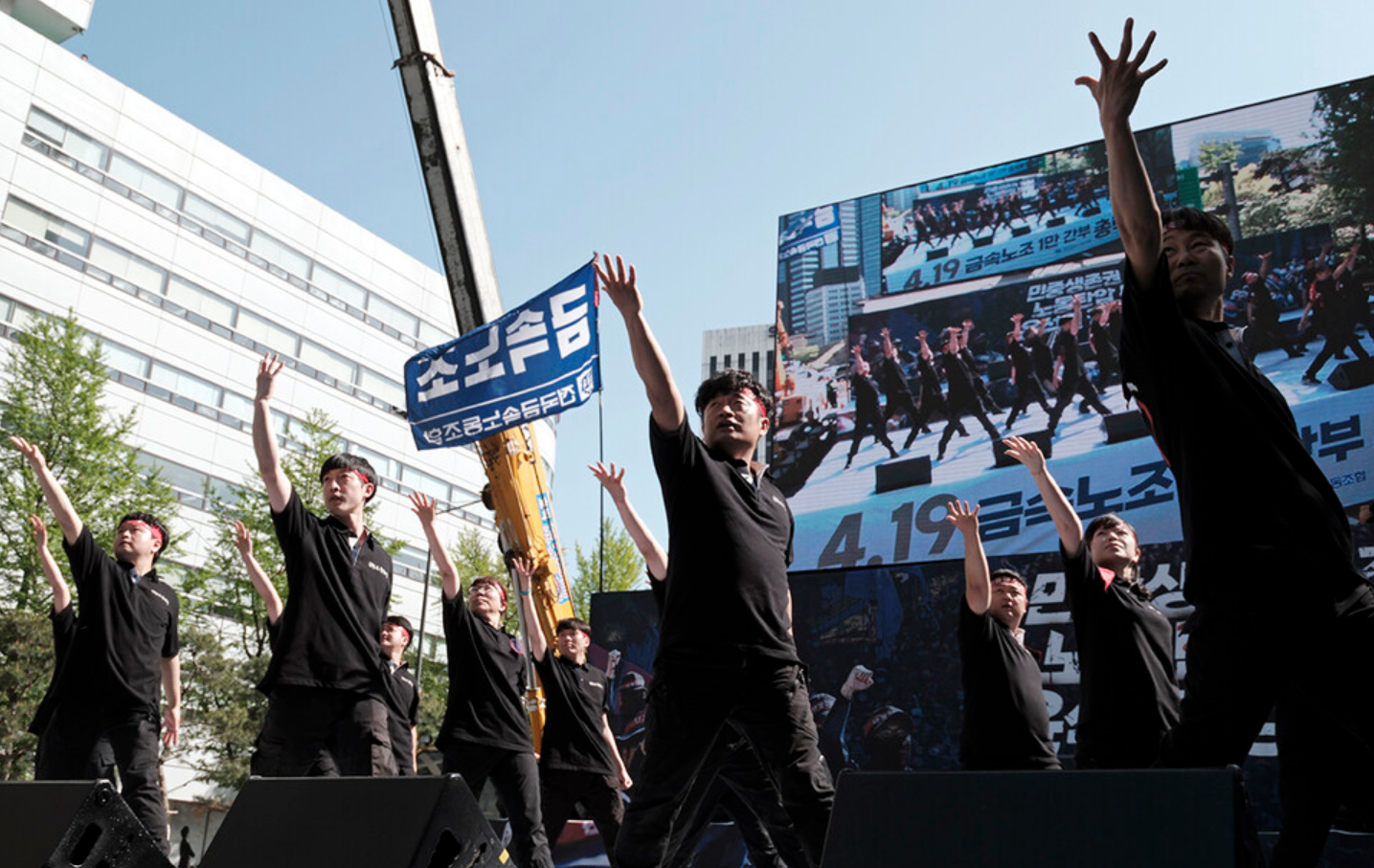Menu
Just Transition Insights, Issue #22, 10/02/2023
By Jonathan Tasini
|

Leading Off: The Korean Auto Workers Views
As part of a project focused on electric vehicles, we have recently been discussing the state of Just Transition with our colleagues at the Korean Metal Workers’ Union, which represents auto workers.
Generally speaking, the landscape in Korea for auto workers breaks down into two categories, according to the KMWU:
- The national auto assembly companies (for example, Kia and Hyundai) with which the union believes it has enough leverage and written agreements to negotiate strong Just Transition standards;
- The supplies of the assembly companies which have undergone a significant capital concentration over the past 20 years and are increasingly dominated by foreign owners. Here, the union has far less influence because the decision-making power is, our colleagues report, often made in headquarters outside of Korea.
While it is true that the union recently inked wage increases in a new pact with Hyundai, the company is aggressively moving to build capacity abroad, especially in the southern United States where it has been harder for unions to organize. As one example, Hyundai is aiming to expand to 8,100 workers, with an up to $7.6 billion investment, at a non-union Georgia electric vehicle and manufacturing batter plant—which would be part of an overall Hyundai-tied workforce, either employed directly by the company or through joint ventures, of more than 30,o00 workers. This also comes, as we’ve noted in the past, on the heels of Hyundai’s use of child labor in at least one of the company’s supplies in Alabama.
The KMWU laid out a set of principles at the end of 2022 that it is pressing the national government to adopt and adhere to:
Strengthen measures to protect workers at components makers during the transition period:Introduce a policy for Short-time Work Benefit paid directly to workers at components makers in crisis, strengthen the social safety net:
- Make retention of total employment an obligation for components makers receiving government support, Guarantee job change support services to workers at risk of job loss.
- Guarantee paid education and training hours for automotive components active workforce, link them to local job programs.
Create quality jobs in the future car components sector:
- Change approval criteria for auto components business reorganization, introduce obligation to create quality regular jobs.
- Guarantee fundamental trade union rights, recall subsidies if unfair labor practices are discovered.Ascertain the situation of illegal labor dispatch in the future car components sector, and punish severely.
Guarantee equal and actual (bona fide) participation of labor in the process of establishing, implementing, and stocktaking/assessing future car transition policies:
- Compose a labor/government as well as tripartite consultative framework for the just transition of the automotive industry.
- Immediately implement labor-government negotiations to redesign auto components industrial policy and labor policy.
We will continue to evaluate the progress of the KMWU’s efforts in future issues of the newsletter.
SPONSOR MESSAGE
A message from the Australian Mining And Energy Union
We are fighting back, not just for ourselves but for the future generation of mineworkers. Workers deserve better. Our families and communities deserve better. Visit us

Spotlight: Wanted—Just Transition Deals With Teeth
In our last issue, we highlighted a specific concern about terms of U.S. government leases being executed in off-shore wind projects to point to a larger problem: how can Just Transition ever be “high bar”, or even attain a minimal standard, if there are no enforcement “teeth” in agreements?
To recap: in the leases we discussed there exists a clause that requires that a successful bidder “make every reasonable effort to enter a Project Labor Agreement(s) (PLA) that covers the construction stage of any project proposed for the leased area, and that applies to all contractors.” PLAs are agreements found mostly in the construction industry, and establish terms of employment for all workers on a project, including wages and fringe benefits; the agreements typically are negotiated with unions in the building trades and require the project contractors to hire workers through union hiring halls.
It was unclear what “every reasonable effort” means, or how that requirement is enforced. So, we asked.
The answer from the Bureau of Ocean Energy Management (BOEM), a department within the U.S. Department of the Interior that is the front-line agency responsible for these leases:
BOEM does not have the regulatory authority to mandate the use of PLAs. However, PLAs remain a policy priority for the Administration, and BOEM encourages their use in lease conditions that state that lessees shall make every reasonable effort to enter a PLA. Whether such an effort has been made would be a case-by-case determination based on the particular facts.
In other words, for all intents and purposes, the clause requiring PLAs is a feel-good statement. Consider a similar scenario in which every rental agreement for a home or office space only required that the lessee make “every reasonable effort” to pay the monthly rent.
A fundamental idea of any Just Transition agreement has to be: every element has to be mandatory and enforceable. The ideal circumstance would place such agreements within a collective bargaining relationship. However, given the paucity of collective bargaining throughout the globe, at minimum, Just Transition frameworks have to contain legally binding language, with clear enforcement tools backstopped by government agencies and carrying heavy penalties for violations.
Ideas: No “Forced Labor” Isn’t Just Transition
Standards are important in any framework. That’s especially the case as we seek a “high bar” Just Transition. Here’s a terrific example to keep in mind.
We pointed out very recently that First Solar, a leading U.S.-based global manufacturer of solar panels, had discovered that four of its subcontractors in Malaysia had used forced labor. Let’s take at face value for this discussion that the company was not aware prior to the independent audit that forced labor existed in its supply chain.
As part of a public explanation of its labor practices, the company said this just a week ago:
One of First Solar’s advantages, Mr. Widmar said, is that it is not as exposed to the use of forced labor, which human rights groups and U.S. government officials say is common in China’s western Xinjiang region.
The framing of the standard of what is considered acceptable for workers is given a huge boost by the journalist who wrote an article that clearly suffered from a significant misunderstanding (willful or not) of labor standards:
Human rights activists worry that as manufacturers ramp up solar panel production, forced labor, sometimes referred to as “modern slavery,” will become more common. Walk Free, a human rights group based in Australia, estimates that 50 million people around the world lived under forced-labor conditions in 2021, about 10 million more than in 2016.
And:
Michael Carr, executive director of the Solar Energy Manufacturers for America, a trade group, said more domestic manufacturers like First Solar were needed to ensure that the United States had a secure supply of panels untainted by forced labor.
“The module manufacturing in the United States is starting to happen,” Mr. Carr said. But, he added, “our international competitors have built up a really sizable lead.”
It should be quite obvious to our regular readers what is missing: First Solar, and virtually the entire solar energy industry, is non-union. A point that is never made in the entire article that effective poses a standard for livable wages—and a “high bar” Just Transition vision—as “forced labor” versus everything else.
Without collective bargaining, any hope that solar jobs will be a part of a “high bar” Just Transition is a mirage.

Opinion: Just for Whom? Australia’s Auto Closure Lessons
By Gemma Beale
In October 2017 car manufacturer Holden, part of the General Motors Company, produced its last red Commodore and, in doing so, marked the end of 70 years of car making in Australia. The closure was significant. The industry had played a pivotal role in the development of the nation’s broader manufacturing industry and was a key generator of secure full-time employment and skills-based career paths for workers. The loss of the industry has not only led to the loss of secure and ongoing work but also seriously impacted Australia’s advanced manufacturing capabilities and sovereign self-sufficiency.
Following the closure’s announcement, in late 2013, a suite of federal, state, and company-funded programs was put in place to assist workers in transitioning into new jobs. Each program offered varying levels of assistance in finding information about job opportunities, identifying transferable skills and skills gaps, funds for retraining, referrals to health services, and ongoing support and mentoring. These programs were demonstrably informed by existing literature on the importance of comprehensive support programs.
However, the closure was distinct from past closures in Australia in that although it happened during a period of relative economic stability, there was a clear and well-documented growth in precarious and insecure work at the time. In a forthcoming book chapter, I draw on a longitudinal investigation into South Australian automotive workers’ transition experiences I conducted between 2018 to 2021 in which I found displaced workers struggled to find work of equal or greater value.
The study followed the same group of workers to gather detailed information on changes in their characteristics, perspectives and employment circumstances over time. It confirmed that precarious work poses a significant risk to workers’ transition experiences following large-scale job loss. In the almost three years following the closure, the only participants not to experience at least one component of precarious work were the participants who were unable to secure any work during this period. It found a high incidence of financial insecurity and poor mental health for participants who did not find enough suitable.
Traditional worker support programs are designed to work within prevailing employment landscapes, without the capacity to stimulate job creation. In other words, for conventional programs to be effective, there needs to be enough jobs – ideally good quality jobs – already available to ensure laid-off workers can find secure work. Much of the just transitions literature, to date, has concentrated on the importance of creating good quality green jobs, but the automotive closures show improving the quality of work across the board needs to be addressed as a central component of a holistic just transition strategy as many workers move into work outside the green energy sectors. This is doubly true given the employment impacts of decarbonisation and climate change are likely to impact the whole economy. Precarious work represents an underlying risk that is exacerbated during times of crisis and the just transition agenda will be flanked by crisis.
Until recently large-scale layoffs were relatively uncommon and tended to be confined to individual factories or companies. Workers support programs have, consequently, been devised for rare, and temporally and geographically limited closures. The closure of the automotive industry was no different. There were two South Australian transition support centres that opened in early 2014, shortly after Holden announced it would close in 2017, and shut down in early 2019, 15 months after Holden’s closure. An allowance offered to incentivise workers to retrain was withdrawn six months later, at the end of the 2018/2019 financial year.
Past closures have consistently found that transition support programs need to run for an extended period because socially related problems do not tend to emerge until “18 months to two years” after operations cease. This has been attributed to workers delaying seeking help, finding their first endeavour into new employment unsuccessful, or experiencing a “grieving period” that inhibits their ability to make plans.
Evidence from earlier closures also indicates that workers have the best employment outcomes if they retrain before a closure. In practice, auto workers found it difficult – if not impossible – to retrain while they were still working full-time.
The longitudinal insight also showed that participant employment outcomes were not static or linear and the reality of the transition programs ending after 18 months meant the most vulnerable workers found themselves forced into the government’s generic employment program.
Traditional transition support programs have relied heavily on the goodwill of private companies. At the time of the auto closure, Australia was still a consumer market for Holden, Ford, and Toyota. As such, they had a vested interest in maintaining good favour in the community. This is less likely if affected companies do not need to maintain a consumer market – as in the case of primary industries – or as closures and lay-offs become a normalised component of the employment landscape.
In the context of a just transition agenda the suitability of temporally limited and place-based solutions needs to be questioned. Given high rates of insecure work and climate change leading to more frequent, wide-spread, and concurrent disruptions the current transition model, where support for workers is implemented incident by incident is no longer fit for purpose.
The impact of increased natural disasters caused by climate change will compound the issue and will likely leave no industry untouched. Just transition policies must be prepared for concurrent and consecutive employment disruptions that are not confined to primary resource industries. Natural disasters, like industry closure, have been shown to have long-lasting effects on employment. Ultimately it will become illogical for just transition policy to have government intervene in employment support services one company, or one incident, at a time.
Effective transition programs need to be responsive to their overarching employment and policy contexts. Learning the lessons of the automotive closure is vital if Australia is to successfully meet our climate and social development goals. The central lesson of the automotive closure is that Australia’s employment landscape is dominated by insecure employment. The current Australian Federal Labor Government is making positive steps to tackle some of the loopholes in the Fair Work Act that have enabled insecure work to flourish in the country. But more needs to be done.
Incorporating best practice transition support into a centralised national employment support program would better accommodate workers who delay seeking assistance or need further assistance when the first job they find is unsuitable or insufficient. A nationally accessible program would also be better suited to future of employment disruptions. One of the persistent political barriers to an ambitious decarbonisation agenda is the fear of wide-spread job loss – in part because of our punitive and insufficient welfare provisions. To address this fear workers, and their communities, need to be reassured that adequate support will be available to them regardless of location or employment type.
We know that large-scale job loss, especially in the case of industry closure, can have serious and often lasting inter-generational, psycho-social effects on workers and their families and communities. As such, it is vital that interventions, including workers transition support be robust and nationally consistent. A just transition policy agenda must include a broad understanding of both risks and justice for those who will be affected by the transition to a low-carbon economy.
Beale is the Senior Project Officer for Research Impact at the Australian Industrial Transformation Institute.
Links
UAW: The United Auto Workers website for up-to-date information on the current strike.
Table of Contents
Leading Off
The Korean Auto Workers Views
Spotlight
Wanted—Just Transition Deals With Teeth
Ideas
No "Forced Labor" Isn't Just Transition
Opinion
Just for Whom? Australia’s Auto Closure Lessons
Links
This Week's Links
Can’t wait to subscribe to the newsletter?
*We post information pursuant to the U.S. Fair Use Doctrine, and applicable international standards, in order to advance the knowledge base and education of our global audience. We endeavor to include the original link to documents. However, upon requests of original authors of posted documents, where explicit use permission is not granted, we will remove documents if it is determined continued use is not appropriate. We also reserve the full right to not include, or remove, any data inconsistent with our mission.















